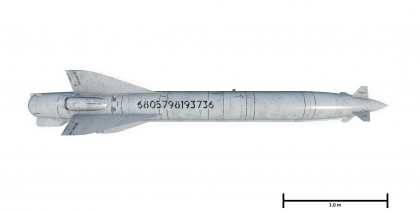Difference between revisions of "Kh-23M"
(→Vehicles equipped with this weapon: Updated) |
(Added introduction and history) (Tag: Visual edit) |
||
| Line 2: | Line 2: | ||
[[File:WeaponImage Kh-23M.png|thumb|left|420px|The Kh-23M missile (scale is approximate)]] | [[File:WeaponImage Kh-23M.png|thumb|left|420px|The Kh-23M missile (scale is approximate)]] | ||
{{Break}} | {{Break}} | ||
| − | + | The Kh-23M is a modernized variant of the Kh-23, which itself is an evolution of the Kh-66. The 23M is designed to attack small ground and naval targets. Controlled by command radio guidance, a tracer element was used to determine the position of the missile as it was guided to the target. The warhead is a 108kg shaped charge/fragmentation warhead, capable of penetrating 250mm RHA. | |
=== Vehicles equipped with this weapon === | === Vehicles equipped with this weapon === | ||
| Line 28: | Line 28: | ||
'''Pros:''' | '''Pros:''' | ||
| + | |||
* | * | ||
'''Cons:''' | '''Cons:''' | ||
| + | |||
* | * | ||
== History == | == History == | ||
| − | + | The story of the Kh-23M starts with the K-66. The K-66 used an K-8 missile air frame with the beam ridding guidance systems of the K-5 AAM. The K-66 was a stop gap measure as it required the pilot to maintain a dive to guide the missile. Regardless it entered service in 1968. Meanwhile development on the Kh-23 continued. Improvements to the motor were made, but the largest different was the switch from the beam guidance system to radio guidance, similar to that of the American bullpup system. The new guidance system allowed the missile to be fired form level flight. The Kh-23 entered service in 1973, a further advanced missile, the laser guided Kh-25, was developed form the Kh-23 with improvements being back-ported to form the Kh-23M which entered service in 1974. A continuous problem with the Kh-23M was the pilot had to pay active attention to guide the missile, meaning in hostile airspace guidance of the missile was usually deprioritized in favor of defensive maneuvers. | |
== Media == | == Media == | ||
| Line 41: | Line 43: | ||
== See also == | == See also == | ||
''Links to the articles on the War Thunder Wiki that you think will be useful for the reader, for example:'' | ''Links to the articles on the War Thunder Wiki that you think will be useful for the reader, for example:'' | ||
| + | |||
* ''reference to the article about the variant of the weapon;'' | * ''reference to the article about the variant of the weapon;'' | ||
* ''references to approximate analogues by other nations and research trees.'' | * ''references to approximate analogues by other nations and research trees.'' | ||
| Line 46: | Line 49: | ||
== External links == | == External links == | ||
''Paste links to sources and external resources, such as:'' | ''Paste links to sources and external resources, such as:'' | ||
| − | * | + | |
| − | * | + | * https://www-airwar-ru.translate.goog/weapon/avz/x23.html?_x_tr_sl=auto&_x_tr_tl=en&_x_tr_hl=en-US&_x_tr_pto=ajax,elem&_x_tr_sch=http |
| + | * https://en.wikipedia.org/wiki/Kh-23_Grom | ||
{{Missiles}} | {{Missiles}} | ||
[[Category:Suspended armaments]] | [[Category:Suspended armaments]] | ||
Revision as of 14:12, 31 August 2021
Contents
Description
The Kh-23M is a modernized variant of the Kh-23, which itself is an evolution of the Kh-66. The 23M is designed to attack small ground and naval targets. Controlled by command radio guidance, a tracer element was used to determine the position of the missile as it was guided to the target. The warhead is a 108kg shaped charge/fragmentation warhead, capable of penetrating 250mm RHA.
Vehicles equipped with this weapon
General info
Tell us about the tactical and technical characteristics of the missile.
Effective damage
Describe the type of damage produced by this type of missile (high explosive, splash damage, etc)
Comparison with analogues
Give a comparative description of missiles that have firepower equal to this weapon.
Usage in battles
Describe situations when you would utilise this missile in-game (vehicle, pillbox, base, etc)
Pros and cons
Summarise and briefly evaluate the weaponry in terms of its characteristics and combat effectiveness. Mark pros and cons as a list.
Pros:
Cons:
History
The story of the Kh-23M starts with the K-66. The K-66 used an K-8 missile air frame with the beam ridding guidance systems of the K-5 AAM. The K-66 was a stop gap measure as it required the pilot to maintain a dive to guide the missile. Regardless it entered service in 1968. Meanwhile development on the Kh-23 continued. Improvements to the motor were made, but the largest different was the switch from the beam guidance system to radio guidance, similar to that of the American bullpup system. The new guidance system allowed the missile to be fired form level flight. The Kh-23 entered service in 1973, a further advanced missile, the laser guided Kh-25, was developed form the Kh-23 with improvements being back-ported to form the Kh-23M which entered service in 1974. A continuous problem with the Kh-23M was the pilot had to pay active attention to guide the missile, meaning in hostile airspace guidance of the missile was usually deprioritized in favor of defensive maneuvers.
Media
Excellent additions to the article would be video guides, screenshots from the game, and photos.
See also
Links to the articles on the War Thunder Wiki that you think will be useful for the reader, for example:
- reference to the article about the variant of the weapon;
- references to approximate analogues by other nations and research trees.
External links
Paste links to sources and external resources, such as:
- https://www-airwar-ru.translate.goog/weapon/avz/x23.html?_x_tr_sl=auto&_x_tr_tl=en&_x_tr_hl=en-US&_x_tr_pto=ajax,elem&_x_tr_sch=http
- https://en.wikipedia.org/wiki/Kh-23_Grom




